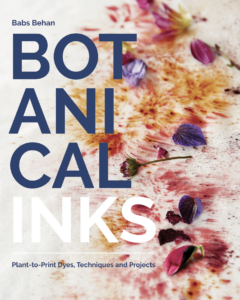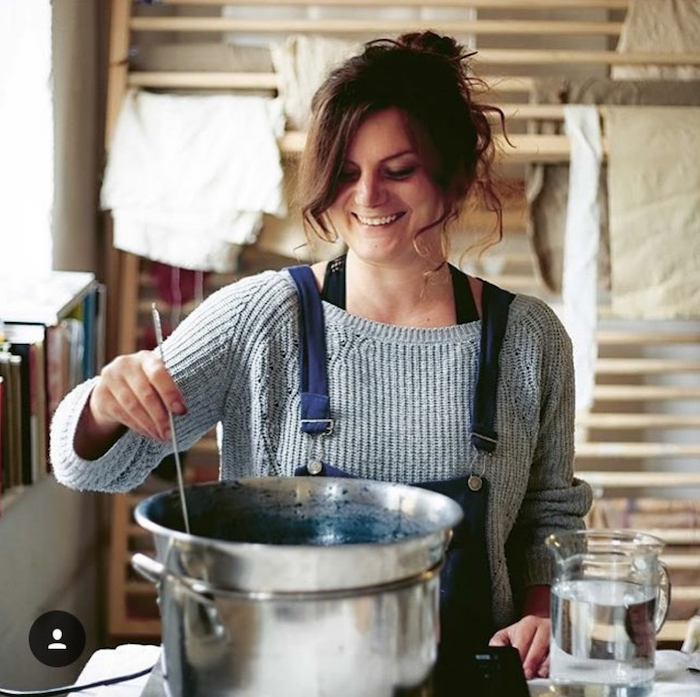Bristol Cloth with Babs Behan
Hey Babs! You work with fabrics and dying for Botanical Inks in Bristol. Everything done there is very much hands-on, local and sustainable. Could you tell me a bit about your background, and what your involvement has been with the project?
Yes, sure. I’m a natural dyer and owner of Botanical Inks natural dye studio in Bristol, and the Bristol Cloth project.. I have been researching global natural dyeing traditions and developing my creative natural dye practise for the past 17 years, since I my first experience in Jaipur, India where I did an internship with a master natural dyer and woodblock printer. I’ve spent much of my life since then travelling the world and visiting different land based communities who still grow and use natural dyes for textiles and paper arts, including Quechuan wool and alpaca dyers in Peru, silk dyers and weavers in Laos, cotton dyers and weavers in Indonesia, Southern India and Mexico.
For many years of producing clothing using end-of-roll natural dye block print fabrics and vintage silk saris, I took a change of direction and decided to focus my energy into researching British heritage natural dyeing and developing a catalogue of locally grown and foraged colour samples on local wool fleece. I found this process so inspiring that I started to share it in groups workshops, which quickly gained a lot of interest. I went from teaching local groups in Bristol to extract colour from local sources, to teaching at Soho House, the Barbican Centre, Saatchi Gallery and Tate St. Ives. After a couple of years of teaching and offering private natural dye commissions, I was offered a book deal and published my book, “Botanical Inks Plant-To-Print Dyes, Techniques and Projects” in 2018 with Quadrille Books.
One of my earliest interviewees was Milly Melbourne, who at the time spoke of the start of the Bristol Cloth project. Can you tell me what the project is, and how it has progressed in the last 2-3 years?
With so much interest in natural dyes and local textile systems, it felt like a timely moment to launch a Crowdfunder for the UK’s first locally grown, natural dyed and woven textile production. Raising £18k over 3 months allowed me to buy regeneratively farmed lambswool from 15 miles outside Bristol in the Mendip Hills @Fernhillfarm and dye it using heritage British dye plants, madder root and weld flower, to create a reddish orange, and then have 200 metres woven into tailoring cloth and scarves at Bristol Weaving Mill, for an audience of 450 Crowdfunder pledgers. The project was quickly picked up and featured on BBC Countryfile, BBC News Points West and Sky News, featured in the Telegraph Magazine, Selvedge Magazine and numerous other papers and magazines. With such a strong moment in the limelight, it seemed like a great time to launch a second Bristol Cloth production of another 200 metres, using a different natural dye colour-way to mix things up and offer something fresh. This production sold out 50% within 30 minutes of launching and can now be purchased from my website www.bristolcloth.co.uk and from local sustainable artisan stores Ottowin in Bristol and Oaken in Falmouth.
I’ve now also launched a third textile production, using the most luxurious natural dyes, organic indigo and pink madder root, on the only Cashmere fibre farmed in England, to create a limited edition collection of blanket scarves, which I dip dyed to create beautiful unique patterning on each one, making them truly special wearable textile pieces.
You mentioned a book you wrote called Botanical Inks – Plant-to-Print Dyes, Techniques and Projects. What will readers of this book learn, and is it suitable for someone without experience with inks and dyes? What has the response been to the book?

It’s a comprehensive guide to natural dyeing from start to finish, going through sustainable fibre and dye sourcing, prep, colour extraction, using mordants, modifiers, surface design techniques like Shibori and bundle dyeing, turning dyes into inks for drawing + printing and paints for paper and textiles. It’s a great book for total beginners to get all the basics and lots of inspiration for creating their own projects and for more experienced dyers who would like to learn more about specific techniques and recipes. I think its been very popular because its so generous with information and offers simple to follow step-by-step recipes with exact measurements, which I think sets it apart from many other natural dye books on the market. It’s had a hugely overwhelming response, with over 20,000 copies sold worldwide in the north America, Europe and Australia & New Zealand plus translated into french and german. The feedback I get from people is amazing and often people refer to the book as their “Bible” which they keep with them when dyeing and even teaching their own workshops.
What would you like to offer up as your WFTP hidden gem?
I always say, if you haven’t already, go look up Fibershed.org and learn about the Fibershed model of making things with local fibres and dyes as a truly sustainable and ecological approach to making and design. This has been one of the biggest inspirations for me in my work for sure and I hope so for everyone.
Cheers Babs, it’s been lovely to hear about Botanical Inks and Bristol Cloth. Please give us your links and social media channels so we can follow what you do!
FB/IG: @Botanicalinks and @Bristolcloth

Interview by Alex Wilson